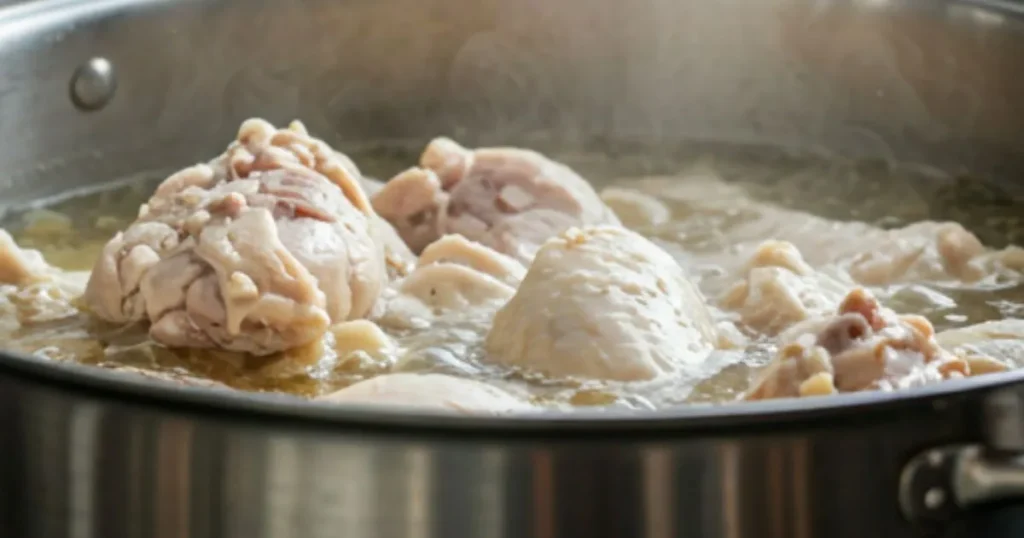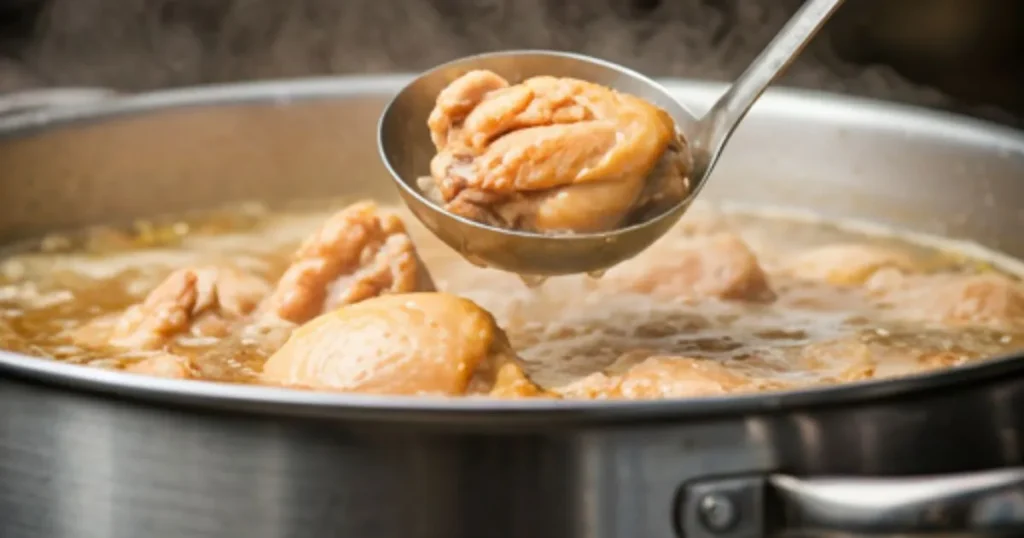There’s something magical about a warm bowl of sopa de pollo that brings comfort not just to your body, but to your soul. Whether you’re curled up on a rainy day, recovering from a cold, or craving a taste of home, this traditional chicken soup is the perfect dish to soothe both your appetite and your spirit. For many families, sopa de pollo is more than just a meal—it’s a cherished tradition, passed down through generations, that embodies love, care, and warmth.
But what makes sopa de pollo so special? Why does it hold such a prominent place in many cultures, especially in Latin America? In this article, we’ll explore the secrets behind making the most delicious and comforting sopa de pollo, revealing step-by-step techniques, key ingredients, and tips for creating a hearty soup that can bring joy to any table. Whether you’re new to cooking or looking to perfect your recipe, you’ve come to the right place!
Table of Contents
Why Sopa de Pollo is a Timeless Favorite
Cultural Significance
You’ve probably noticed that sopa de pollo isn’t just a dish—it’s a part of many people’s cultural fabric. Originating from Latin American and Spanish cuisine, sopa de pollo is much more than a simple meal. It’s a symbol of family, warmth, and tradition. In almost every Latin country, this chicken soup recipe varies slightly, but the core idea remains the same: a nourishing, healing dish designed to bring comfort to the soul.
The cultural importance of sopa de pollo stretches far beyond its delicious taste. For many, it’s a go-to remedy when feeling unwell, a way to provide a comforting meal when family gathers, or simply a reminder of home. Whether it’s prepared in a rustic kitchen or served at a lavish family dinner, sopa de pollo is a staple of home-cooked meals.
Health Benefits
Beyond its emotional comfort, sopa de pollo is also known for its health benefits. It’s a go-to for soothing a sore throat, calming digestive issues, and promoting overall well-being. The ingredients work in harmony to offer an array of nutrients, making it a rich source of vitamins and minerals.
- Immunity Boost: The chicken in sopa de pollo is a great source of lean protein, which helps boost your immune system. It’s also packed with amino acids that help fight infections and reduce inflammation.
- Digestive Aid: The hot broth is incredibly soothing to the digestive tract, making it an excellent choice when you’re feeling under the weather or suffering from stomach issues.
- Hydration: The broth keeps you hydrated, and the vegetables added to the soup provide much-needed vitamins and minerals.
When combined with fresh vegetables like carrots, celery, and garlic, sopa de pollo becomes a healthful powerhouse that nourishes both body and mind.
Key Ingredients for the Perfect Sopa de Pollo
The magic of sopa de pollo lies in the ingredients. While the recipe may differ depending on the country or family tradition, certain key ingredients remain constant. Here’s a breakdown of the essential components of a traditional sopa de pollo.

Chicken – The Heart of the Soup
The chicken is the backbone of this dish, and the choice of chicken plays a crucial role in the flavor of your broth. When making sopa de pollo, it’s best to use bone-in chicken, such as a whole chicken or a combination of chicken thighs and drumsticks. The bones provide a rich, deep flavor that you can’t get with boneless chicken. If you want to take it a step further, consider using a whole chicken for maximum flavor and texture.
- Bone-in vs. Boneless: While boneless chicken can be used for a quicker version of the soup, bone-in chicken adds more depth to the broth. The collagen from the bones creates a rich and velvety texture.
- Whole Chicken: Using a whole chicken offers both meat and bones, which give the soup its signature richness.
Fresh Vegetables – Adding Flavor and Color
The vibrant colors of the vegetables not only add a pleasing aesthetic to your soup, but they also boost the nutritional value of the dish. In a traditional sopa de pollo, the following vegetables are commonly used:
- Carrots: These sweet, crunchy vegetables infuse the broth with a natural sweetness that balances out the savory flavors.
- Celery: Adds a refreshing, slightly peppery flavor that complements the richness of the chicken.
- Corn: In some variations, fresh corn on the cob is added for a burst of natural sweetness.
You can also include other vegetables like potatoes, peas, or squash to create different variations and textures.
Aromatics – Building Flavor Layers
The base of the soup relies on a carefully selected set of aromatics. These are the ingredients that provide the flavor foundation for the broth:
- Onions: A must-have for building depth in your broth. Use a large onion, cut into quarters, so it can easily infuse the soup with its flavors.
- Garlic: Fresh garlic cloves add a savory, slightly pungent kick that enhances the overall taste of the broth.
- Cilantro: Fresh cilantro is often used as a garnish, adding brightness and a hint of citrusy freshness to the finished soup.
Broth Base – Simplicity is Key
The key to a flavorful sopa de pollo is the broth, which should be clear, rich, and full of flavor. While you can use store-bought chicken broth in a pinch, nothing beats the flavor of homemade broth made from scratch. Here’s why:
- Homemade Broth: Cooking the chicken with water and vegetables for a couple of hours extracts the full flavor from the meat and bones, creating a rich and hearty base.
- Stock vs. Water: Using chicken stock instead of water will deepen the flavor of the broth. Stock is made by simmering chicken bones, vegetables, and seasonings for a long time, resulting in a more concentrated flavor.
Step-by-Step Guide to Making Traditional Sopa de Pollo
Now that you’re familiar with the ingredients, let’s break down the process of making sopa de pollo step by step. You’ll find that making this traditional dish is simpler than you think, but the end result is nothing short of incredible.
Preparing the Chicken and Broth
- Clean and Boil the Chicken: Start by rinsing the chicken and cutting it into large pieces if you’re using a whole chicken. Add the chicken to a large pot and cover with cold water.

2. Bring to a Boil: Set the pot over medium-high heat and bring the water to a boil. As the water heats up, you’ll notice foam rising to the surface. Use a spoon to skim this off, as it can make the broth cloudy.

3. Simmer the Chicken: Once the foam is removed, reduce the heat to low and let the chicken simmer gently for about 1.5 to 2 hours. The longer the chicken simmers, the more flavorful the broth will be.

4. Add Aromatics: After the chicken has simmered for about an hour, add the onions, garlic, and herbs. Let these cook with the chicken for the remaining time to infuse the broth with rich flavors.

Adding Vegetables and Cooking
- Add Vegetables: Once the chicken is tender and the broth has developed its flavor, it’s time to add the vegetables. Start by adding the carrots, corn, and celery. Let the vegetables cook for about 20-30 minutes until they’re tender but not mushy.
- Seasoning: Taste the broth and season with salt and pepper to taste. You can also add a touch of lime or vinegar for extra brightness, depending on your preference.
The Finishing Touch
- Shred the Chicken: Pull the chicken out of the pot and give it a few minutes to cool down. Once cool enough to handle, shred the chicken into bite-sized pieces, removing any skin and bones.
- Return the Chicken to the Soup: Add the shredded chicken back to the soup, stirring it in to ensure it’s evenly distributed.
- Garnish and Serve: Ladle the soup into bowls, garnish with freshly chopped cilantro, and serve with lime wedges or tortillas for extra flavor.
Sopa de Pollo Variations Across Latin America
As you’ve learned, sopa de pollo is a versatile dish that can be adapted to suit different tastes and regional preferences. While the base ingredients remain the same, there are unique variations found across Latin America that add exciting twists to the classic recipe.
Mexican Sopa de Pollo
In Mexico, sopa de pollo often includes fresh lime, avocado, and crispy tortilla strips. These additions bring a refreshing and slightly tangy element to the soup. Common spices include cumin and chili powder, adding a mild heat that gives the soup an extra layer of flavor.
Cuban Sopa de Pollo
Cuban versions of sopa de pollo may include ingredients like plantains, yuca, and sweet potatoes, which add a rich, starchy element to the soup. Cuban recipes often feature oregano and a dash of vinegar for extra brightness and tang.
Dominican Sopa de Pollo
Dominican sopa de pollo often includes sofrito (a mixture of sautéed onions, garlic, and bell peppers), which serves as the flavor base. It also incorporates yautía (a type of root vegetable) and lime juice to brighten the dish.
Tips and Tricks for a Delicious Sopa de Pollo
While making sopa de pollo is simple, there are a few insider tips that can take your soup from good to amazing.
- Simmer, Don’t Boil: The key to a clear, flavorful broth is simmering your chicken, not boiling it. Boiling can make the chicken tough and cause impurities to cloud the broth.
- Add Fresh Herbs: Add cilantro, parsley, or thyme at the end of cooking to preserve the freshness and vibrancy of the herbs.
- Use a Slow Cooker: If you have the time, making sopa de pollo in a slow cooker allows the flavors to meld beautifully. Simply add all the ingredients and let it cook on low for 6-8 hours.
Nutritional Facts: What Makes Sopa de Pollo a Healthy Meal?
Traditional sopa de pollo is not only delicious, but it’s also a healthy option for those looking for a nourishing meal. Below is a detailed summary of its nutritional value:
- Calories: A serving of sopa de pollo contains approximately 150-200 calories, making it a light yet filling meal.
- Protein: With around 18 grams of protein per serving, this soup is an excellent source of lean protein, which helps build and repair tissues.
- Vitamins and Minerals: The vegetables in sopa de pollo are packed with vitamins A, C, and K, as well as potassium and magnesium.
Nutritional Facts per Serving
| Nutrient | Amount per Serving (1 cup) |
|---|---|
| Calories | 150-200 kcal |
| Protein | 18g |
| Carbohydrates | 15g |
| Fat | 7g |
| Fiber | 2g |
| Sodium | 400mg |
Conclusion: A Bowl of Comfort, Tradition, and Flavor
Now that you’ve learned the secrets to making a traditional sopa de pollo, you’re ready to create a meal that’s as comforting as it is flavorful. Whether you’re enjoying it on a quiet evening or sharing it with loved ones, this dish has the power to bring people together and evoke cherished memories. So, gather your ingredients, roll up your sleeves, and enjoy the simple yet profound pleasure of a homemade sopa de pollo.
Don’t forget to share your experience and the recipe with friends and family—after all, the best dishes are those shared with others. Happy cooking!
——————————————-

Sopa de Pollo
Ingredients
- Bone-in chicken such as a whole chicken or 4-5 chicken thighs and drumsticks: 1.5 to 2 pounds (about 700-900g)
- Carrots: 2 large peeled and sliced
- Celery: 2 stalks sliced
- Corn on the cob optional: 1-2 ears, cut into halves or thirds
- Onion: 1 large quartered
- Garlic: 4 cloves smashed
- Cilantro: 1/4 cup chopped (for garnish)
- Salt: 1-2 teaspoons to taste
- Black pepper: 1/2 teaspoon to taste
- Lime optional, for garnish: 1, cut into wedges
- Water: 8 cups about 2 liters or chicken stock for extra flavor
Instructions
Preparing the Chicken and Broth
- Clean and Boil the Chicken: Start by rinsing the chicken and cutting it into large pieces if you’re using a whole chicken. Add the chicken to a large pot and cover with cold water.
- Bring to a Boil: Set the pot over medium-high heat and bring the water to a boil. As the water heats up, you’ll notice foam rising to the surface. Use a spoon to skim this off, as it can make the broth cloudy.
- Simmer the Chicken: Once the foam is removed, reduce the heat to low and let the chicken simmer gently for about 1.5 to 2 hours. The longer the chicken simmers, the more flavorful the broth will be.
- Add Aromatics: After the chicken has simmered for about an hour, add the onions, garlic, and herbs. Let these cook with the chicken for the remaining time to infuse the broth with rich flavors.
Adding Vegetables and Cooking
- Add Vegetables: Once the chicken is tender and the broth has developed its flavor, it’s time to add the vegetables. Start by adding the carrots, corn, and celery. Let the vegetables cook for about 20-30 minutes until they’re tender but not mushy.
- Seasoning: Taste the broth and season with salt and pepper to taste. You can also add a touch of lime or vinegar for extra brightness, depending on your preference.
The Finishing Touch
- Shred the Chicken: Pull the chicken out of the pot and give it a few minutes to cool down. Once cool enough to handle, shred the chicken into bite-sized pieces, removing any skin and bones.
- Return the Chicken to the Soup: Add the shredded chicken back to the soup, stirring it in to ensure it’s evenly distributed.
- Garnish and Serve: Ladle the soup into bowls, garnish with freshly chopped cilantro, and serve with lime wedges or tortillas for extra flavor.
Notes
Nutrition Information (Per Serving):
- Fat: 7g
- Protein: 18g
- Carbohydrates: 15g
- Fiber: 2g
- Sodium: 400mg
- Vitamin A: 100% of the Daily Value
- Vitamin C: 25% of the Daily Value
Frequently Asked Questions (FAQ) About Sopa de Pollo
Can I make sopa de pollo ahead of time?
Yes! In fact, sopa de pollo often tastes even better the next day as the flavors have more time to develop. Place the soup in a sealed container and refrigerate it for up to three days.
Can I swap out bone-in chicken for boneless?
While boneless chicken can be used in a pinch, bone-in chicken is preferred for making a flavorful broth. The bones release collagen and nutrients that create a rich, hearty base.
Can I freeze sopa de pollo?
Absolutely! You can freeze sopa de pollo for up to 3 months. Make sure the soup is fully cooled before you move it to an airtight container or freezer bag to store it safely.
How can I make sopa de pollo spicier?
To add a little heat, try including some diced jalapeños, chili peppers, or a dash of hot sauce. Modify the heat level according to your personal preference.

4 thoughts on “Sopa de Pollo to Make You Feel Amazing”